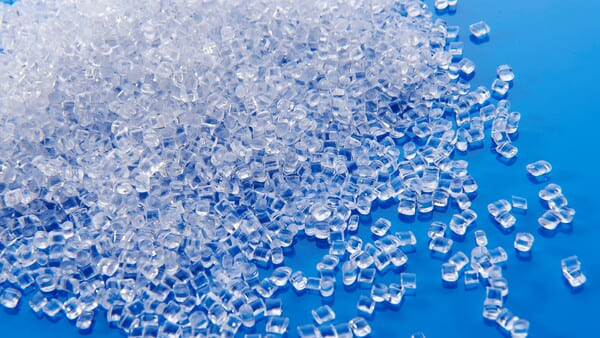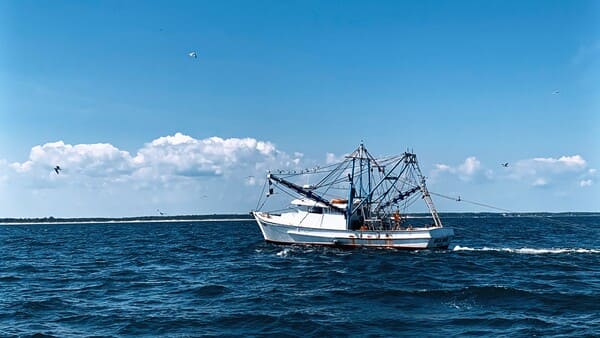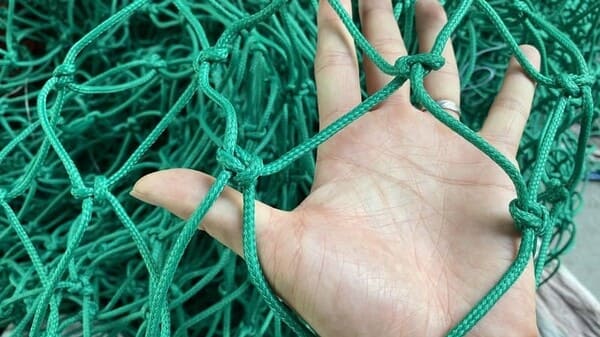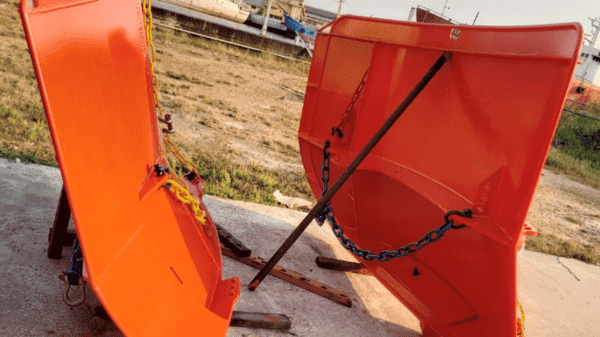Description
A trawling net is a type of fishing gear used in commercial fishing to catch fish and other marine organisms.
It is a large net that is towed behind a fishing vessel through the water, with the mouth of the net open to catch fish and other marine creatures.

How it works
- Ensure trawling net is suitable for your target fish and the vessel works well.
- Take the boat to the target waters, and adjust the speed based on the target species and water conditions.
- Release the net slowly into the water behind the boat, ensuring that it is positioned correctly for the target species.
- Once the trawl has been completed, retrieve the net slowly to avoid losing any fish. If the catch is large, it may be necessary to use a winch to pull the net in.
- Sort the catch, separating any unwanted or undersized fish, and store the remaining fish in a cool, dry place.
Types of trawling
According to the location of fishing, the trawling could be classified into bottom trawl and pelagic trawl.

These are trawling nets that are designed to fish near the bottom of the ocean. They are used to catch demersal fish species such as cod, haddock, and flounder.

These are trawling nets that are designed to fish in the middle or surface water. They are used to catch pelagic fish species such as herring, mackerel, and tuna.
Types of trawling
According to the methods of fishing, the trawling could be classified into otter trawl, pair trawl, beam trawl, demersal trawl, multi rig trawl, out rig trawl, twine rig trawl.

The otter trawl consists of a large net with a mouth that is held open by two large metal doors or “otter boards.” The otter boards are designed to spread the net open as it is towed behind a fishing vessel.

The beam trawl is similar to the otter trawl, but it uses a single metal beam instead of two otter boards to keep the net open. This type of trawl is often used to catch flatfish such as flounder and sole.

These are trawling nets that are towed by two fishing vessels. The nets are spread out between the two boats and are used to catch large fish such as halibut and tuna.
Proposal of trawling
The fishing net in different market is different, so most of the trawling nets are customized. You can talk with us directly if you have any questions.
Main Parts of trawling
There are several differences between the bottom trawl and pelagic trawl. but the main structure is the same.

- Nets - are sewed by many different fishing nets by piece. it includes the wings, body and codend.
- Otter boards - are large metal plates that are attached to the net and used to keep the net open in the water.
- Bridle - is a set of ropes or chains that connect the doors to the trawl net. The bridle helps to control the speed and direction of the net.
- Headrope - attached to the top of the net to keep it suspended in the water column.
- Footrope - is a weighted rope or chain that is attached to the bottom edge of the trawl net.
Production of Trawling net
The fishing nets of different parts are different, and they should be sewed together piece by piece. And then the floats, ropes and other parts should be installed.
Net weaving
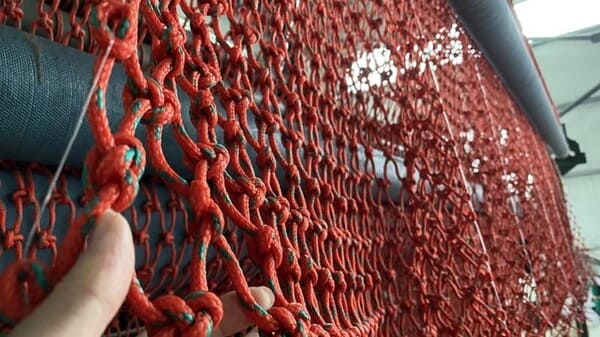
The different fishing net need be produced in advance. the process is the same as other fishing net.
installation

Then we should sewed them togtether with ropes by hand. and then the floats and other parts should be installed with the nets
packing

After installation, the trawling net should be packed by piece. and it should be easy for shipping.
How to choose the nets
Choosing the right nets for a trawling net depends on several factors, here is the key facotors you should consider.
Material
- HDPE - The most popular one is HDPE, the main reason is cheap, which it could be afford by most of fishermen.
- Polyester - it has higher strength than HDPE, and it is softer. so it is suitable to be used as parts of trawling net, such as end cod.
- Nylon - it has similar properties as polyester, but it has better water absorption. The price would be higher than polyester.
- UHMWPE - it is a more and more popular choice for trawling net. It has best mechanical properties in plastic material. So the weight would be much lighter in same strength. It can reduce the fuel comsuption.
Types of nets
- Braided net - it is the most popular choice for most of fishermen, because it has better abrasive resistance. this is very important for bottom trawl.
- Twisted net - some fishermen choose the PE twisted net. It is cheap enough for most fishermen.
- Multifilament net - the multifilament net is also a good choice, the material could be nylon, polyester or UHMWPE. it is soft enough to protect the fish inside. it is usually used as the inner layer or cod end.
Size Of trawling net
- Power of vessel - it determines the size of trawling net. You should ensure that the power of vessel is big enough to handle the total weight of trawling net and fishes inside.
- Target species - Different species inhabit different depths in the water column. Choose a net depth that corresponds to the typical location of your target species to increase the chances of capturing them effectively.
- Types of trawling net - The size of bottom trawling and pelagic trawling is different.
Twine of nets
- Strength - The twine determines the strength of the nets. The twine's breaking strength should be able to support the load of the catch and withstand the pressure of being dragged through the water.
- Abrasive Resistance - Trawling nets are subject to wear and tear due to friction with water, rocks, and other obstacles.
- Cost - The twine is bigger, the weight of trawling net will be heavier, so the cost would be higher.
Mesh size of nets
- Target Fish - The mesh size should be large enough to allow small and juvenile fish to escape while retaining the larger target species.
- Bycatch - If the area has a high bycatch rate of non-target species or endangered species, a bigger mesh size may be required to reduce bycatch.
- Regulation - Make sure to review the regulations in the area where you will be fishing to ensure compliance.
Colors
- Type of Fish - some fish are more attracted to brightly colored nets, while others may prefer darker colors that blend in with the water.
- Water Conditions - If the water is clear, a more transparent or lighter colored net may be appropriate. If the water is darker or murky, a darker colored net may be more effective.
- Preference - Different colors represent different qualities in some market, it is easy for fishermen to identify the quality they want.
How to choose the accessories
PVC & EVA Floats
- Buoyancy - EVA floats are generally more buoyant than PVC floats in same size.
- Durability - PVC floats are more durable than EVA floats.
- Comfort - EVA floats are softer and more cushioned. PVC floats are often harder and less forgiving.
- Cost - PVC is cheaper than EVA.
Groundgear
- Seabed - Rocky bottoms may require a lighter gear with rubber rollers, while sandy bottoms may require a heavier gear with steel plates.
- Fish - Larger fish may require heavier gear, while smaller fish may require lighter gear.
- Regulations - Some areas may have restrictions on the use of certain types of gear to protect the seafloor or reduce bycatch.
- Experience - More experienced fishermen may prefer certain types of gear based on their personal preferences and past successes
Otter
- Size of the Trawl Net - A heavier or larger trawl net will require a larger and heavier otter.
- Water Depth and Current - A larger and heavier otter may be needed in deeper water and stronger currents.
- Shape - The shape of the otter should match the shape of the trawl net.
- Material - The most popular material is steel, it depends on the fishing environment.
How to buy a trawling net
you have 2 options: buy a completed trawing net from the supplier. the other option is buy the fishing net by piece and make the trawling net in your country by yourself.
Proposal discuss

If you have the drawings of trawling net, you could talk with the details with your supplier. if you just want to buy the fishing net, you could show them the specifications and quantity.
Quotation

When all the details is confirm, you can get the quotation from your suppliers. And you would compare the prices between the suppliers.
Samples check
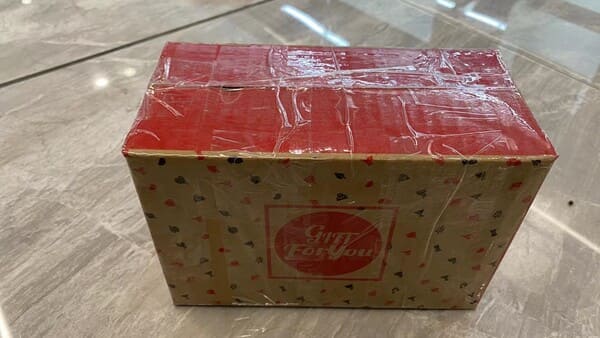
To check the quality, you could ask the suppliers for the samples to check their quality. You also could check the photos and videos of their production.
Order comfirm
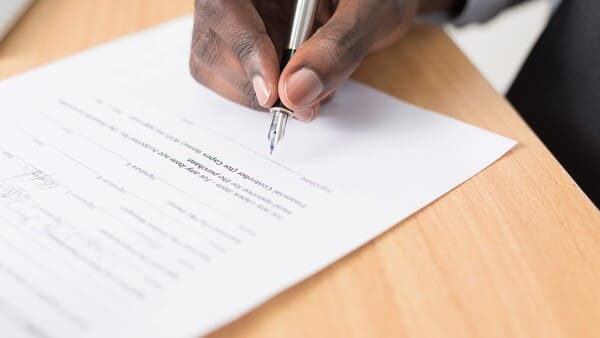
After comparing the price and quality, you would have a discuss with your management, and decide to choose the best supplier.
Production

The supplier will start to produce the trawling net as your requirement. You could ask the photos and videos of the production several weeks later.
shipping

All the goods will be loaded into the container when it is prepared. As usual, the supplier will share the photos or videos of loading with you.
Let's talk now!


